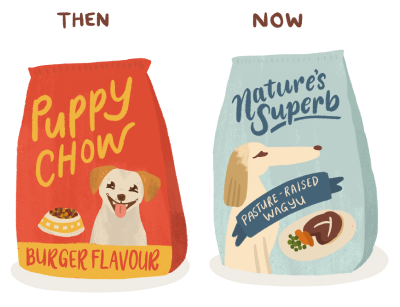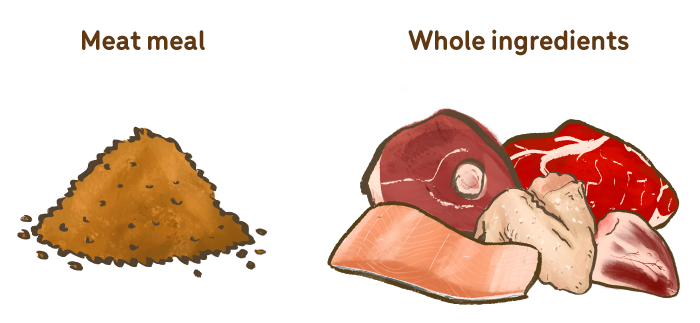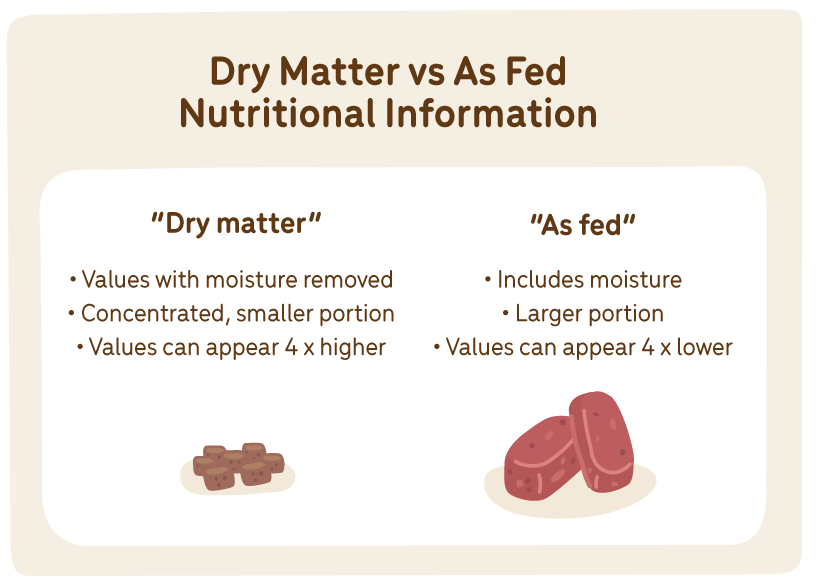Decoding dog food labels


How do I read my dog's food label?
If you’ve ever tried to make sense of the too-good-to-be-true claims and percentages-that-don’t-seem-to-add-up-to-100 on a bag of dry dog food, you’re not alone. Anyone who has attempted to decode a commercial pet food label recently will know it is enough to send even the most savvy consumer into a tail spin. Gone are the days of mystery meats and colourful chow; we are deep in the territory of all natural superfoods and pasture raised proteins. But what does this mean for consumers trying to navigate the overwhelming amount of information they’re presented with on the pet shop shelves? In this article we go over some important things to remember next time you select a dog food.
Ingredients

Ingredients on pet foods are listed in order of weight, from heaviest to lightest, just like in human food. This is an easy one, but there are still some tricky things to look out for here. The first thing is the meat content. We know that dogs thrive on a meat based diet, so naturally we would hope to see meat in number one position. This may come in the form of “whole” meat, or meat meal. The key difference between the two is that whole meat is weighed before the water is removed, and meat meal is a heavily concentrated meat powder. Meat is around 75% water, so if you see whole meat and then a long list of dry ingredients, it’s highly unlikely that meat is really the main ingredient in the finished product. And it’s probably not necessary to point out that if an ingredient list can’t pinpoint the actual protein it contains, but instead lists “beef and/or poultry and/or pork,” they’re also not able to guarantee any degree of quality. Actually being able to identify the animal the meat comes from is a very low bar to meet.
Another thing to be mindful of when reading an ingredient list of something called ingredient splitting. Ingredient splitting is when one food is split across multiple entries so there appears to be more or less of it in the finished product. In the case of meat, it’s common to see both meat meal and whole meat, when in reality all meat in a kibble style food ends up being a concentrated powder devoid of water. Including both makes it appear that there is twice as much, when really it is likely just water that’s taking up space in the ingredient list.
In the case of less desirable ingredients, like flours and other carbohydrate sources, ingredient splitting is used to push items down the list and make it appear as if there is less of them. If you see something like “rice” and then a few stops later “rice flour,” it’s reasonable to say there is considerably more rice in the food than they would like you to know. Similarly, if a food lists four different legumes, this is less about nutritional variety (legumes are fairly nutritionally lacklustre across the board for canines) and more about the lack of appeal in a bean based dog food.
Proteins
Truly transparent products will list everything in a comparable form, name individual cuts of meat – because they know which ones goes into their food – and group ingredients like vegetables together so they sit in the ingredients list in a way that accurately reflects their portion in the food.
Understandably, this questionable approach to ordering ingredients by weight can leave consumers wondering how much beef is really in their bag of “beef” dog biscuits. The requirements for naming a product by a particular protein are actually set out in the labelling guidelines of the industry standards, however, in order to be simply labelled “beef” a variety must contain only 20% meat (any meat), and at least a quarter of that must be beef. This means that in real terms, “beef” dog food need only contain around 6% beef! If the food is labelled “with beef” it can contain even less. Many foods these days advertise they are “with real beef,” which suggests there is some sort of artificial beef alternative, when really they are likely required to add the “with” due to the miniscule amount of “real beef” the food actually contains.
You would also be wise to take any lofty claims of high meat percentages (eg. “contains 80% kangaroo”) on the front of a bag of dry food with a grain of salt, as these are permitted to be made based on the “whole” meat portions, inclusive of the 75% water that is removed during processing. In reality, most processed commercial dog foods only ever contains powdered meat meal, so this rehydrated meat percentage claim is purely hypothetical, calculated using a “rehydration factor” to reverse engineer an ingredient that never actually existed in the food in this form. It also means that if you tallied all of the other actual ingredient percentages, you’d get well over 100%, which just doesn’t add up.
The use of percentages
Speaking of percentages that don’t add up, if you interrogate the nutritional information panel on a bag of commercial dog food, you will often find that there are a number of key nutrients missing, and the total is well below 100%. This is because the pet food industry standards only require that protein and fat are listed. These must be listed as crude protein and crude fat, but this actually just means the total value contained, which is the same as for human food. What’s almost always missing is carbohydrates, sometimes along with fibre, ash and moisture. There’s a very good and simple reason this information is missing – they don’t want you to know because it’s widely accepted that dogs and cats don’t require carbohydrates in any significant portion. Despite this, it’s not uncommon for processed commercial food to contain upwards of 40% highly refined carbohydrates. A truly transparent brand will list all of these nutrients for a total of 100%, so consumers trust they can accurately decipher the nutritional value of their pets’ food – or you can use the Big Dog carbohydrate calculator to work it out!

These percentages may be listed as “dry matter” or “as fed,” depending on the food. As fed values include moisture, whereas dry matter refers to the values with all moisture removed. Fresh foods will generally use the as fed values to describe their food, in line with the way human food is labelled, and as a result they often appear to be far lower in protein and fat than dried foods like kibble. But dried foods are effectively a concentrate, and as a result the portions sizes are much smaller. If you were to compare a brand of dry dog food to its wet equivalent, you will see the protein and fat portions are around 4 x higher in the dry food, but the serving size is far smaller. The actual amount of protein doesn’t change; it is simply a percentage of a much smaller portion in the variety with all of the moisture removed. This is something to be mindful of when determining the true protein content of a food – a higher percentage doesn’t always mean more protein.
One thing that you will generally see on all dog food varieties is an indication of which life stage the food is designed for – puppies, adults or all life stages – and if the food is formulated to a certain set of nutritional standards. It’s important to always select the life stage that best reflects your pet’s age, and ensure that the food is nutritionally balanced. The industry nutrition standard in Australia is the AAFCO standard, and food that is formulated to meet this will generally tell you as much, either by naming this organisation or by using an expression like “complete and balanced” on their packaging. These standards aren’t perfect, but they are a good baseline to ensure you are feeding a diet that meets the minimum nutritional requirements of your four legged friend. The quality of the ingredients some products use to achieve this is another story, but looking for a food that meets these standards using fresh, whole food and without the need for being heavily supplemented with synthetic nutrients is a good start.
Superfoods
Finally, a note on superfoods. It’s become increasingly popular for pet food brands to boast that they are brimming with things like blueberries, kale, wheatgrass, turmeric, emu oil, flaxseeds, dandelion and cranberries, but it’s important to interrogate this a little further to determine if there is any actual benefits being provided, or if these are just trendy food fads. In the case of a fresh product like Big Dog, these are absolutely valuable inclusions that provide antioxidants and potent nutritional benefits. In the case of repeatedly heat treated products that are processed so intensely they must be fortified with synthetic nutrients to replace those that didn’t survive the extreme cooking methods, it is highly unlikely that any genuine nutritional benefits remain. And if these ingredients appear after the synthetic vitamins and minerals in the ingredients list, they are in such miniscule portions that it wouldn’t matter if they did.
There’s a reason processed pet food companies don’t let you see behind the curtain like transparent brands like Big Dog; because what you would see is totally at odds with what their labels suggest. All of the juicy chicken breast and lamb chop photos in the world can’t match transparent, honest labelling from brands that truly have nothing to hide. If you find yourself confused reading a pet food label, remember, there is a good chance it’s intentional.
About the Author - Clare Kearney, Pet nutritionist.

Clare Kearney is a pet nutritionist and writer based in Byron Bay, where she lives with her two kelpies, Tex Perkins and Pip. Clare takes a practical but science-based approach to nutrition and has a passion for fresh, whole foods for pets. She has run her consulting business HUNDE since 2015, and through it provides education about pet nutrition and the pet food industry, assisting those who wish to improve their pets’ lives through species appropriate, unprocessed foods. Clare believes that nutrition fundamentally underpins our health and that without fresh, healthy foods we can’t possibly be at our most vibrant. She sees no distinction between us and our animal companions in this respect. Her mission is to empower pet owners with information, so they can make the best possible choices for their whole family, and live long, happy and healthy lives together.
